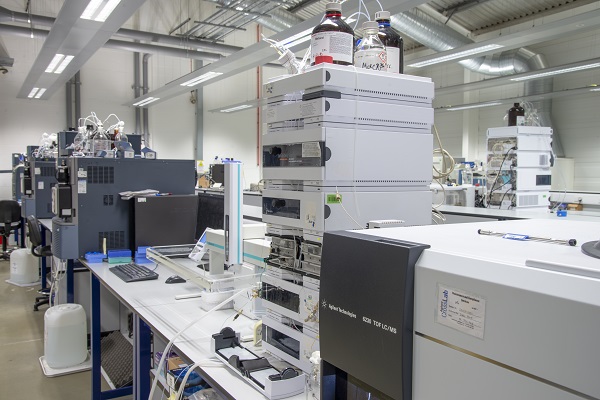"Fera have helped us deliver innovation and wealth creation in key UK industrial sectors"

Visit our other sites
-
Fapas - Proficiency Testing
Globally recognised provider of proficiency tests, running over 400 tests annually across an extensive range of matrices and analytes
-
Great Crested Newts Testing
A single sample taken by an ecologist at any time during the newt breeding season can determine their presence or absence, saving you time and money
- Our leading-edge knowledge, expertise and state-of-the-art technology in assessing the environmental safety of chemicals and minimising their impact on the environment supports the agri-food chain and ultimately protects the consumer.
- Contact Us

At Fera Science Limited we support our partners through world-class science to navigate complex regulatory frameworks.
Fera offers a wide range of analytical services using sophisticated analytical instrumentation. We have the expertise, personnel and equipment to provide clients with assistance in analytical method development in support of environmental toxicology studies, biotechnology, manufacturing support, compliant sample analysis, formulated product analysis, polymer analysis, analytical method validation to GLP requirements and surfactant analysis. Additionally, our leading-edge knowledge, expertise and state-of-the-art technology in assessing the environmental safety of chemicals and minimising their impact on the environment supports the agri-food chain and ultimately protects the consumer.


Examples of our analytical equipment include:
- Velos Pro OrbiTrap (Thermo)
- Triple Quad Mass Spec (AB SCIEX)
- Proton-NMR (Bruker)
- Carbon-NMR (Bruker)
- Acquity Xevo TQ-S (Waters)
- 19 Triple Quad Liquid Chromatography Mass Spectrometers (LCMS)
- 3 Time of Flight (TOF) LCMS
- 2 High Resolution TOF LCMS including Orbitrap technology
- 14 Gas Chromatography Mass Spectrometers (GCMS)
- 3 High Resolution GCMS
- 2 Ion Ratio Mass Spectrometers
- 3 Inductively Coupled Plasma Mass Spectrometers
- 2 NMR
- Liquid Scintillation (Perkin Elmer Tri-Carb)
- Sample Oxidiser (Perkin Elmer 307)
- HPLC-βRAM (Agilent and LabLogic Model 4)
- Laura 4 Radio chromatography (LabLogic)
- TLC Bio-imaging (FUJI-BAS)
14C Radiochemistry Apparatus
Fera has the best people in the right place focussed on delivering the right solution. We continuously invest in our people and support them in delivering the best science to our partners.

Andrew Plumb
Andrew holds a BSc (Hons) in Chemistry from the University of Hertfordshire and is a Chartered Chemist of the Royal Society of Chemistry and a Chartered Scientist of the Science Council.
Our Services
Our analytical chemistry team has over 500 years of experience with particular strengths in method development, chromatography and compound identification. This range of expertise when combined with the latest analytical instrumentation and techniques allows Fera Science to develop, and validate methods for a very broad range of test articles. This includes challenging materials such as environmental samples such as soils and animal tissues, mixtures, UVCB’s, low water solubility species and volatiles, capabilities include:
| Service | Description |
|---|---|
| Residue Analysis | We are proud of being market leaders in pesticide testing & agrochemical residue analysis, with over 50 years’ experience we recognise the need for fast, accurate and reliable analysis to support environmental risk assessment studies. Offering a comprehensive range of accredited and GLP analytical testing and a package of tailored services, we provide wide-ranging support to the food, animal feed & agrochemical industries enabling them to complete pre-registration studies and then deliver the product assurance the market place requires. Our team have knowledge and experience of not only the analysis of individual or groups of residues but also targeted testing specific to certain matrices. Tests include method development and multi-residue screening by GCMS and LCMSMS. Our wide variety of sample types including plant, animal, environmental matrices and their major metabolites under GLP, including method development and validation. With our labs and our experienced staff we will be able to support your plans in a dependable and timely manner. Our studies carried out according to international standards (OECD and SANCO) and in compliance with GLP. |
| Method development | The work in the analytical chemistry section
supports early method development through and onto validation and commercial
support. With decades of experience, our staff will help you design and
successfully execute a phase-appropriate analytical strategy. The method
development will support testing for new chemicals where there is a good chance
there won’t be a well-established method in place for analytically testing.
Also, when existing compounds are used together in a new formulation,
analytical method development might be necessary to test the interactions
within the formulation. |
| Method validation to GLP requirements | Fera has vast experience in analytical validation for a variety of platforms including HPLC, LC/MS/MS, GC/MS or GC/FID, ICP/MS. We support product development of a variety of chemical product. |
| Metabolite characterisation and identification | Fera analytical team implement LC/high-resolution-MS/MS techniques as the major tool for metabolite identification in all study types, supported partially by additional detection technologies such as UV/PDA, or radio detection for the studies where 14C-labelled compounds are used. Modern NMR spectroscopy after upscaled production and isolation of the metabolite is also a valuable tool for both qualitative and quantitative purposes. |
| Determining the magnitude of pesticide residues in in pollen and bee products for human consumption | Honey can potentially contain residues of plant protection products (PPPs) since honeybees may be exposed to such products either directly or indirectly by collection of nectar and pollen. Residues of plant protection products are sometimes found in honey during residue monitoring and levels can vary from one substance to another. It is therefore appropriate to establish safe Maximum Residue Limits (MRLs) for consumers. Fera can help you in determining the levels of PPPs in pollen and bee products |
| Stability testing | When compiling magnitude of residue (MOR) data from crops, crop products and products of animal origin it is essential to ensure that the residues of all components of the residue definitions (both risk assessment and enforcement) of a MOR sample remain accurately quantifiable from the time of sampling /harvest to analysis. If MOR samples are not analysed as quickly as possible after collection, chemical changes to the components of the residue may take place which may lead to inaccurate results. In cases where it is not possible to analyse MOR samples immediately after they have been taken, the MOR sample should be stored under suitable sub-zero ºC conditions until analysis. In these cases the effect of storage conditions on the stability of residues should be investigated. Fera analytical chemistry team can help you complete these studies to fulfil guidelines and GLP requirements. |
| Customised Analytical Testing | Analysis of processed fractions including breakdown/ reaction products. Environmental fate field analytical support including soil sample preparation and soil residue analysis. Ecotoxicology analytical support including dose verification and stability testing in aquatic matrices, field residue analysis in pollen, nectar, wax, honey, bee stomach in addition to independent lab validations. |
| Independent laboratory validation | A validation of the primary method in an independent laboratory (ILV) must be submitted for methods used for the determination of residues in plants, plant products, foodstuff (of plant and animal origin) and in feeding stuff. The ILV shall confirm the LOQ of the primary method, but at least the lowest action level (MRL). Fera can help you to meet the regulatory requirements by conducting GLP independent laboratory validation studies. |
| Formulated product analysis | Fera can help you accelerate your agricultural formulation development to meet the demands of a growing global population and a highly competitive industry with an integrated approach to research, development and regulatory compliance. We will perform analytical testing for new agrochemical products and complex co-formulation mixtures,. Including analytical development services, quality control, stability testing (including GLP stability), batch preparation and factory process transfer analytical support. |
Technologies
The breadth of our technology allows us to integrate technology and informatics establishes us as a centre of diagnostic excellence accelerating the pull through of emerging technologies into real world applications.

Thomson Suite
The Thomson Suite is one of the largest facilities of its kind in the UK. It is a bespoke laboratory running to GLP quality standards that houses 30 state-of-the-art mass spectrometry instruments.
Listen to our team
Fera works closely with plant protection, biocide, animal health and chemical manufacturers to help develop effective, sustainable and safe products that enhance output whilst minimising adverse environmental impacts.
We're looking for the most talented and ingenious minds to help us tackle tomorrow's challenges with an innovative approach. Could you provide the answers?
- Ecotoxicology
- Fate & metabolism
- Livestock metabolism and residue studies
- Efficacy services
- Analytical chemistry
- Consultancy
Original thinking…applied to serve the agro-chem and veterinary medicines industries
We have a wide range of technologies developed and used at our Sand Hutton Site
The Thomson Suite
State-of-the-Art Mass Spectroscopy at Fera
The Thomson Suite is one of the largest facilities of its kind in the UK. It is a bespoke laboratory running to GLP quality standards that houses 30 state-of-the-art mass spectrometry instruments. It was named in honour of Sir Joseph John Thomson (1856 - 1940), a British Nobel Prize winning physicist, whose 1913 experiments are credited with the invention of mass spectrometry.
The Thomson Suite
Bench Top NMR
James Donarski
James speaks about his research into method transfer high resolution mass spectrometry and high field NMR spectroscopy to benchtop instrumentation.
This video was filmed at RAFA 2015, by SelectScience
Nuclear Magnetic Resonance (NMR) Spectroscopy

Copyright © 2025 Fera Science Limited (“Fera”). All rights reserved.
For further information about how Fera uses any personal data collected from you, please see our Privacy Notice at www.fera.co.uk/privacy-policy.



